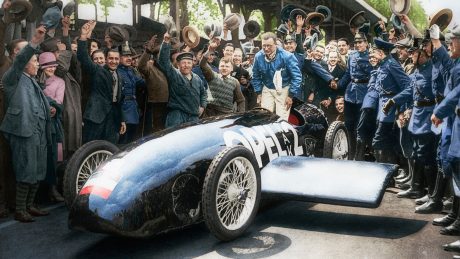*/
]]>
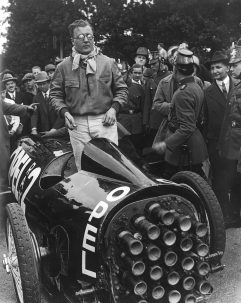
Men with Vision: Fritz von Opel in RAK 2 and Otto Willi Gail, author of the book “With Rocket Power into the World – From the Fire Truck to the Spaceship” (back right, with tie).
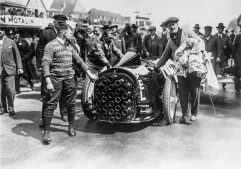
Shortly before the start: The Opel team pushes the RAK 2 on the grid.
May 23, 1928, 10 o’clock in the morning: A futuristic racing car with side wings rushes sharply hissing along the Berlin Avus. The 29-year-old Fritz von Opel, grandson of company founder Adam Opel, has fired the 24 powder rockets in the rear of his RAK 2 one after the other and is chasing the bleachers with a fire tail. As the jet-black shiny car comes to a halt with the large Opel lettering, the approximately 3,000 spectators are completely excited: “Raketen-Fritz” from Rüsselsheim has set a new speed track record with 238 km / h. Moreover, he has impressively demonstrated to a broad public that rocket propulsion is powerful and manageable. Opel heralds the rocket era with the spectacular RAK 2 in front of cameras – the cornerstone of manned space travel.
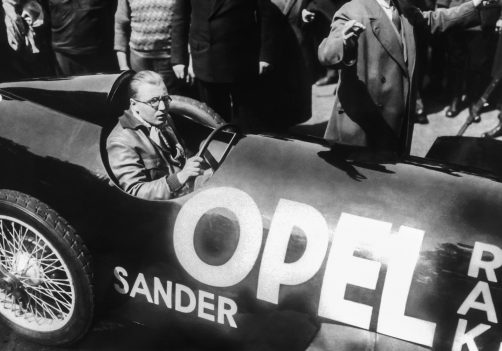
Daredevilly: Fritz von Opel tackled his dangerous record run in the RAK 2 without a helmet.
Automobile manufacturer’s rocket pioneer
The history of the Opel RAK 2 dates back to the fall of 1927. After a meeting with the Austrian publicist and astronomer Max Valier (1895-1930) Fritz von Opel decides to actively participate in its rocket research project. In addition to his own commitment, the racing driver, entrepreneur and graduate engineer also brings the innovative and financial power of the renowned company Opel into the cooperation. On the one hand, because the rocket technology fascinates him personally; on the other hand, because he hopes that the visionary project will generate positive impulses for the Opel brand. Opel Friedrich Sander (1885-1938), whose company produces solid fuel rockets for signal purposes, is getting on board for the rapid implementation of a “rocket engine”.
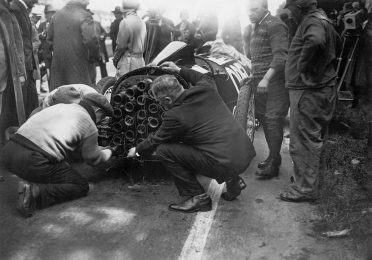
Final preparations: The Opel engineers Becker and Treber (right) have pushed the RAK 2 to its starting position. Technicians of Friedrich Sander wire the rocket loads. In the background, film star Lilian Harvey and Avus boss Hellmuth Reiners pose in front of the cameras of the journalists.
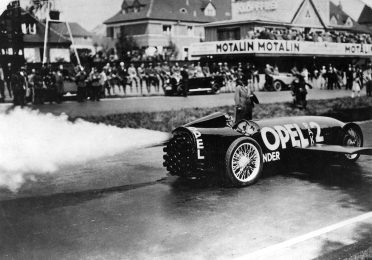
Start free: Fritz von Opel launches the first rocket in the rear of the RAK 2 by foot pedal.
First rides in Rüsselsheim
The collaboration between Valier, Sander and Opel already bore fruit in March 1928. The first prototypes with rocket propulsion on the Opel test track in Rüsselsheim will be launched to the exclusion of the public. On April 11, the Opel RAK 1 achieved with Opel engineer and racing driver Kurt Volkhart at the wheel within eight seconds 100th pace basis of this already equipped with small side wings car is an Opel 4/12 hp. For its drive, twelve Sander rockets with around 40 kg of explosives are mounted in the rear. Proof of the usability of the rocket is provided. Not least due to the huge response in the press, the team agrees that the experiments should be continued at higher speeds. Since the Rüsselsheim home track is not suitable for this, the choice falls on the Avus in Berlin – it has two long straights.
Futuristic design with 24 rockets
The Opel RAK 2 is designed specifically for the Avus record drive on the chassis of an Opel 10/40 hp and is a further development to RAK 1 in several points. It is 4.88 meters longer compared to its predecessor, aerodynamically refined , has larger wings and has 24 solid rockets, which together develop six tons of thrust. The gradual electrical ignition of the charges by pedal in the footwell was maintained. The 560 kg racer with the futuristic design does not have engine and transmission.
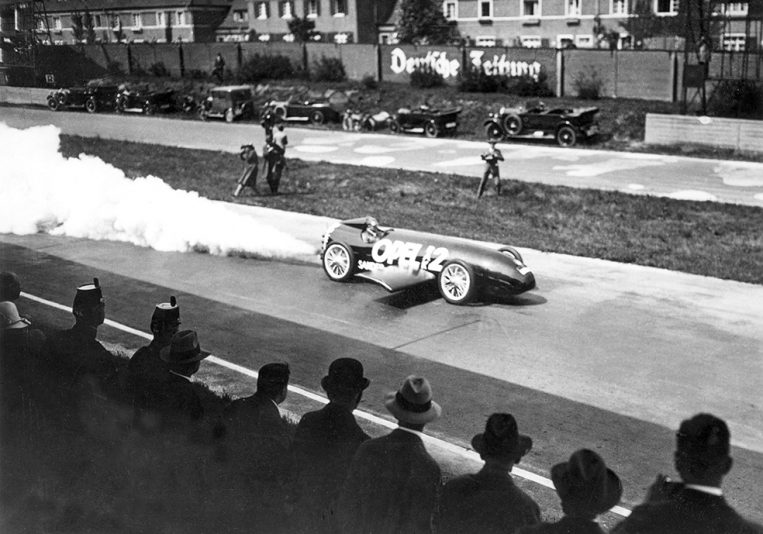
Spectacular: With a sharp hiss and a lot of white smoke, the RAK 2 races past the Avus grandstands.
A utopia becomes reality
As a pilot, Fritz von Opel nominates himself. He plans his groundbreaking appearance in Berlin carefully – technically as well as organizationally. Around 3,000 people, journalists, celebrities, athletes and politicians are invited. The guests are numerous, including boxer Max Schmeling, poet Joachim Ringelnatz, movie stars Lilian Harvey, Thea von Harbou and Metropolis director Fritz Lang, as well as the popular racing drivers Hanni Köhler and Carl Jörns. Before the start, Professor Johann Schütte, chairman of the Scientific Society for Aviation, and Fritz von Opel give prophetic speeches. The radio broadcasts live. After that, the Opel team gets ready. The fitters August Becker and Karl Treber free the Opel RAK 2 from a canvas tarpaulin and push it carefully to the launch site. Only there are the rockets installed and connected to the ignition mechanism. Police clear the way, Fritz von Opel takes place behind the large wooden steering wheel. Significantly, Friedrich Sander shakes his hand. The excited whispers in the stands are silenced. Then it goes fast.
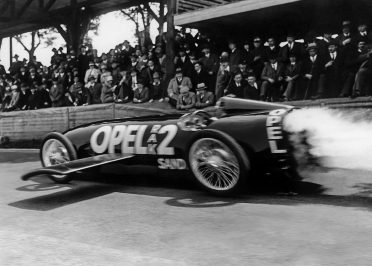
“Rocket Fritz” in retrospect: “I step on the ignition pedal. Behind me it howls and throws me forward. … I kick again, again and – it grabs me like a rage for the fourth time. Everything disappears sideways. … The acceleration is a rush. I’m not thinking anymore. The reality disappears. I only act in the subconscious. Behind me the lawn of the unruly forces. “
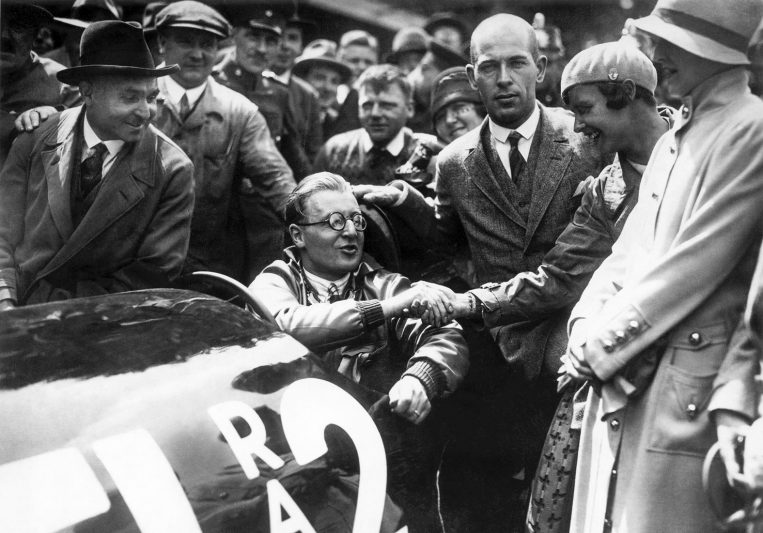
In the finish: Fritz von Opel receives congratulations from the motorcycle racer Hanni Köhler. Next to her, Max Valier looks into the camera at first sight. Far left Opel racing legend Carl Jörns, right in the foreground Lilian Harvey.
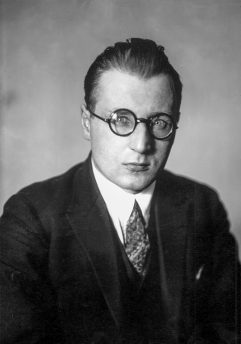
Versatile talent: Dipl-Ing. Fritz von Opel (1899-1971) was a gifted athlete, pilot, engineer and entrepreneur.
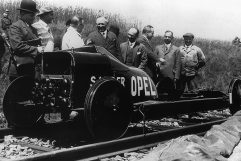
World record on the rail: the rocket-draisine Opel RAK 3 was 256 km / h fast.
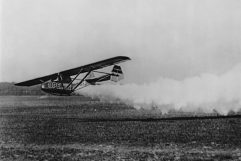
First rocket flight in the world: Fritz von Opel takes off in autumn 1929 with the Opel-Sander-RAK 1 from the Frankfurt airport Rebstock.
The Rüsselsheimer copes with the north curve and the rearing of the car, because the wings do not provide enough downforce for the breakneck speed. After almost three minutes, everything is over. The RAK 2 slowly rolls out, the big white clouds of smoke dissolve over Berlin under the cheers of the audience in the sky: A utopia became reality, a spectacular triumph. By Opel reached 238 km / h and is nicknamed “Rocket Fritz” overnight to one of the great celebrities of the nation. The Opel brand is now regarded as the most progressive and innovative automaker. The rocket age has begun.
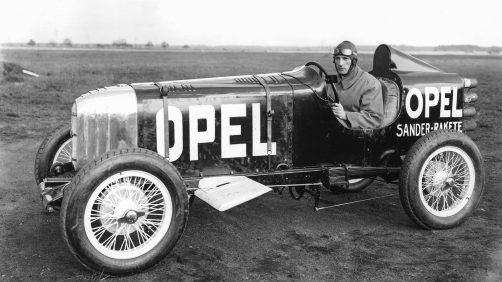
First rocket car in the world: Opel RAK 1, at the wheel Opel engineer and racing driver Kurt Volkhart.
Innovation and technical competence
Inspired by the great success in Berlin, Fritz von Opel and Friedrich Sander continue their experiments. On June 23, 1928, in Burgwedel, they achieved a speed world record for rail vehicles at 256 km / h on the Opel RAK 3 rocket trolley. After trying a motorcycle, the legendary Opel Motoclub, they finally turn their attention to aviation. Thus, on 30 September 1929 in Frankfurt, a renewed pioneering act succeeded: the first public rocket flight in the world with the Opel-Sander RAK.1 built by Julius Hatry. Shortly thereafter, however, the rocket tests at Opel are ended under the impact of the global economic crisis and the development capacity is fully focused on vehicle development. Innovation and technical competence characterize the company Opel, however, to this day. The research and development of new drive technologies is more than ever one of the priority corporate goals.
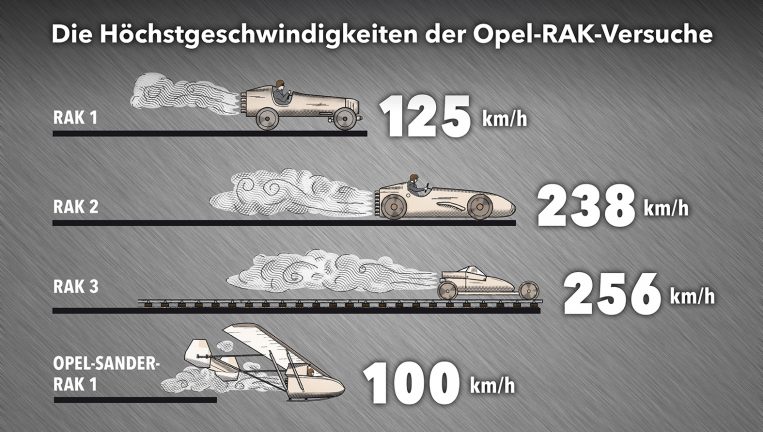
As of May 2018
